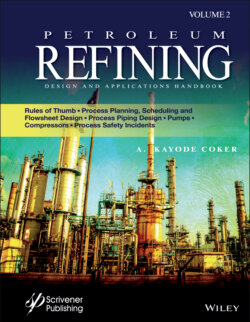Читать книгу Petroleum Refining Design and Applications Handbook - A. Kayode Coker - Страница 36
REFRIGERATION
Оглавление1 1. A ton of refrigeration is the removal of 12,700 kJ/h (12,000 Btu/h) of heat.
2 2. At various temperature levels: −18°C to −10°C (0–50°F), chilled brine and glycol solutions; −45 to −10°C (−50 to −40°F), ammonia, Freon, and butane; −100 to −45°C (−150 to −50°F), ethane or propane.
3 3. Compression refrigeration with 38°C (100°F) condenser requires kW/tonne (hp/ton) at various temperature levels; 0.93 (1.24) at −7°C (20°F), 1.31 (1.75) at −18°C (0°F); 2.3 (3.1) at −40°C (−40°F); 3.9 (5.2) at −62°C (−80°F).
4 4. Below −62°C (−80°F), cascades of two or three refrigerants are used.
5 5. In single-stage compression, the compression ratio is limited to 4.
6 6. In multistage compression, economy is improved with interstage flashing and recycling, the so-called “economizer operation.”
7 7. Absorption refrigeration: ammonia to −34°C (−30°F) and lithium bromide to 7°C (45°F) is economical when waste steam is available at 0.9 barg (12 psig).
